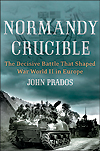
Normandy Crucible: The Decisive Battle That Shaped World War II, by John Prados, NAL Caliber, New York, 2011, $25.95
Few readers yearn for yet another account of the 1944 campaign, but this stimulating work pays more attention to Ultra intercepts (more than did Allied commanders at the time) and considers how the Wehrmacht was able to perform as well as it did.
Military historian John Prados skims through Operation Overlord’s planning, landing and stalemate phases to explore the period just before Operation Cobra, the Allies’ late-July offensive. Its goal was to advance into Brittany and capture more ports—an obsession with the Allies, who weeks into the campaign still strained to import sufficient supplies.
The outnumbered Germans defended brilliantly despite Adolf Hitler’s micromanagement and the July 20 assassination attempt, which did little to hone his sense of reality. U.S. General George Patton gets credit for what followed, when Allied armies broke out to the south and then reversed course in a daring attempt to surround the Wehrmacht. Prados delivers a mild historical bombshell by quoting unit records, correspondence and even Patton’s diary to maintain that Supreme Allied Commander General Dwight Eisenhower originated the idea.
The usual command rivalries, hesitancies and muddled communication meant the Allies never closed the trap, although the Germans suffered terrible losses and apparently fled in disorder. Despite the September debacle at Arnhem, Allied commanders believed the Wehrmacht was a spent force. In November they changed their minds.
Back in June, Hitler had ordered formation of new, stripped-down Panzer brigades and Volksgrenadier divisions with heavy equipment and streamlined training. Ultra cryptanalysts had passed along the news, but Allied leaders had assumed the moves were desperate bottom-of-the barrel measures. In fact, melded with surviving infantry and officers from France, these units, 1 million strong, fought well and provided the punch for Hitler’s final offensive that December.
Astute research and a modestly revisionist approach make this a satisfying history of a familiar subject.
—Mike Oppenheim




